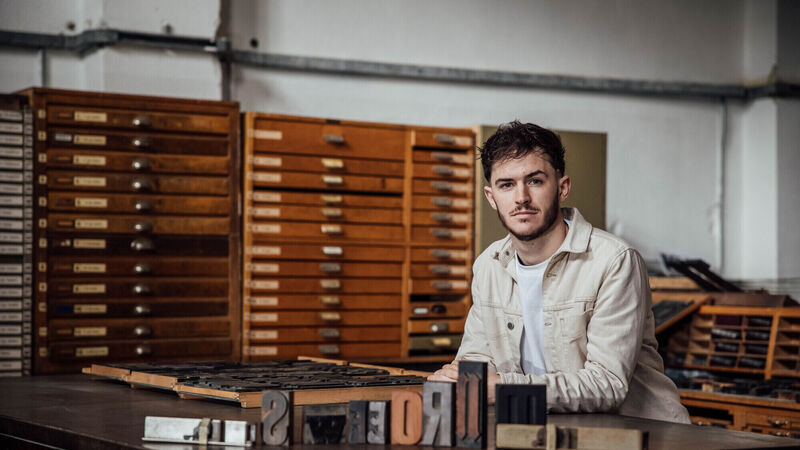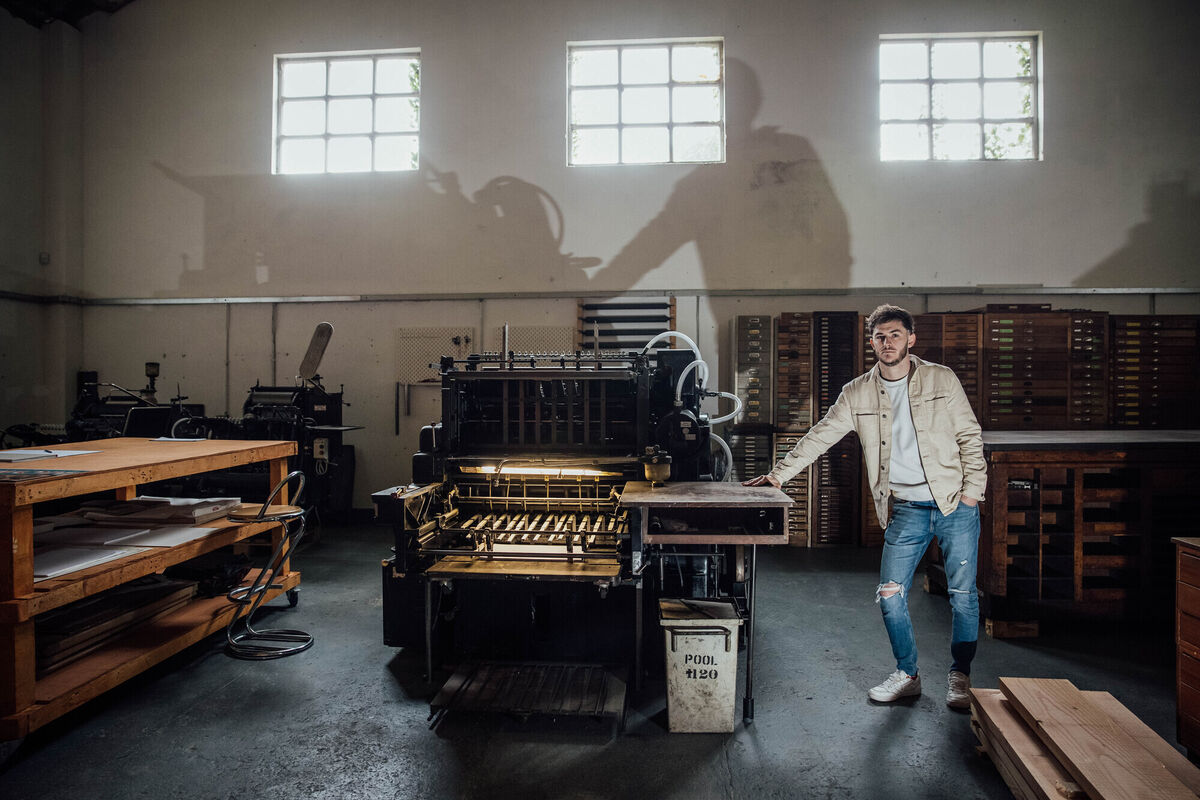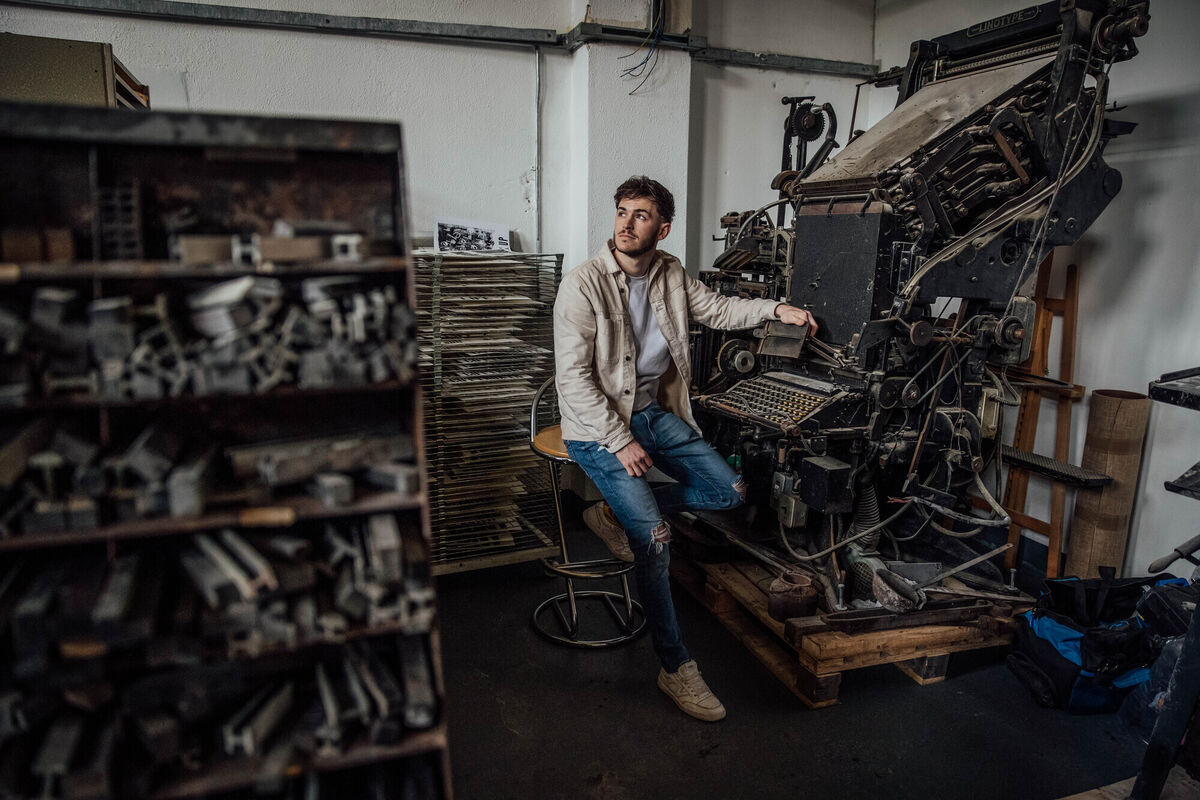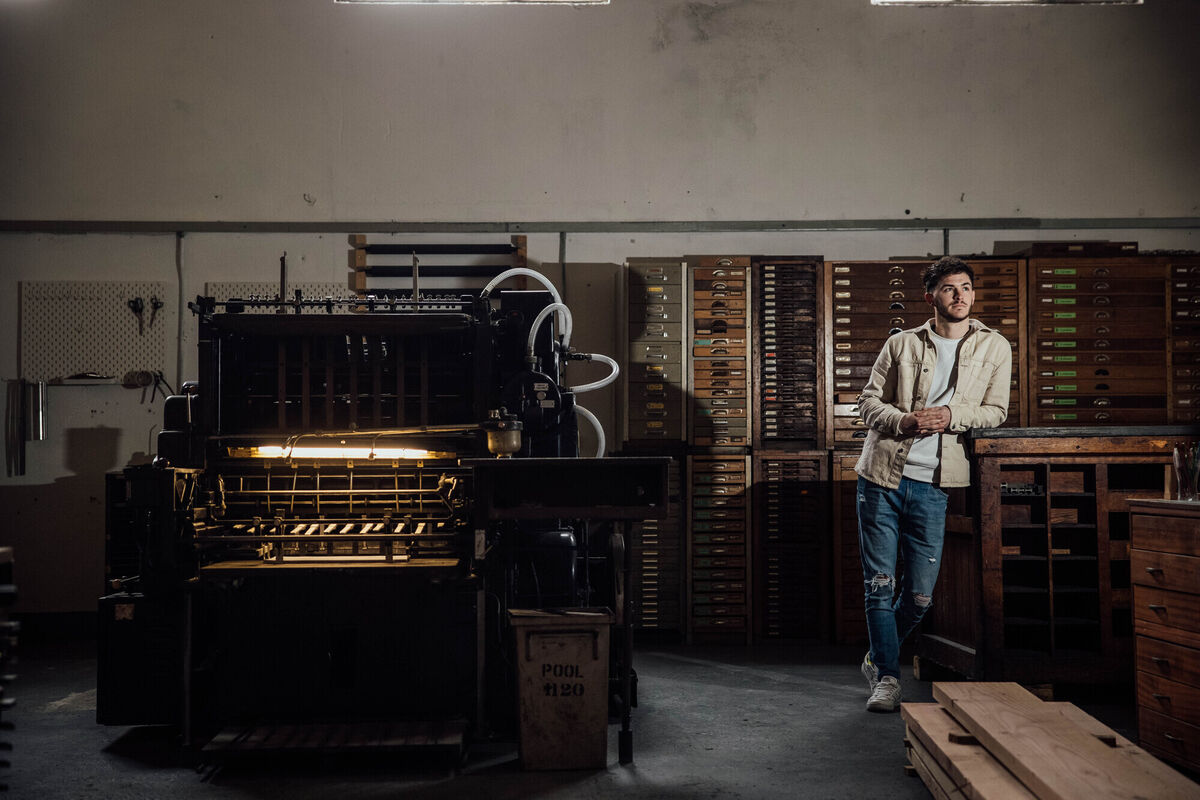Quite the match: Love for printing alive and well in Lisdoonvarna

Conor Burke, Letterpress Printer in Lisdoonvarna. Pictures: Brian Arthur
In an industrial unit on the outskirts of Lisdoonvarna, Conor Burke switches on a machine, and a sound that has long been consigned to history begins to echo around the cavernous building.
The hums and whirrs are the sound of a printing press, one of a large collection of machines from the 19th and 20th centuries that Conor has amassed in the workshop of his fledgling printworks, The Gentian Press, in the Co Clare town.
“I got this one from an old printers’ in Ennis,” Conor says over the sounds of the machine. It’s a rare Heidelberg cylinder press, built in Germany in 1958.
Although there are several in use for cutting paper, it’s the only machine in Ireland with a restored inking unit, that is capable of printing.
Even across Europe and the UK, there are only a handful of these presses in use, most famously in England, where Glastonbury Festival’s in-house newspaper, the Glastonbury Free Press, is printed on one.
An eight-tonne cast-iron behemoth, Conor’s Heidelberg, as well as the other machines surrounding him, are relics of a craft that was once nearly lost.
As printing technologies have advanced and then digitised, many machines like these – and the collections of lead and wooden typefaces that they use — have ended up on the scrap heaps of history.
“When we moved to digital and these machines weren’t needed any more, everything was thrown out,” Conor says.
“There’s pictures online of old print houses four-storeys high with people literally throwing wood type from the top story windows; big massive piles of wood type, just being burned.”
“I’ve inherited them the way they are, and they need to be kept this way so they can continue to be used for the next generation.”
The power of the printed word The moveable type printing press, first designed in Germany by Johannes Gutenberg in the 1440s, is of course considered one of the most revolutionary technological inventions in human history.

The fast reproduction and dissemination of everything from religious texts to political manifestos, the birth of newspapers and the advertising industry: none would have been possible without the printing press.
And up until digital printing techniques were developed throughout the latter half of the 20th century, print meant some form of letterpress.
In letterpress, ink is applied to the raised surface of letters or “type,” and then the arrangements of characters are pressed onto paper. But hand-setting type is labour-intensive: Newspapers once employed vast teams to do this work.
“You know the phrase ‘mind your Ps and Qs?’” Conor says, “Well, that came from the fact that the typesetters were working in reverse because all the type is backwards. A lower case P and a lower case Q are easy to confuse.
“Even the terms ‘upper case’ and ‘lower case’ literally come from the fact that the capital letters were stored in a case above the lower case letters.”
Conor, who grew up in Lisdoonvarna, fell in love with letterpress printing while studying graphic design in National College of Art and Design (NCAD) in Dublin. He now teaches art in his own former school, Mary Immaculate Secondary School.
For a college project, Conor made a limited edition book in NCAD’s in-house Distiller’s Press, which has a Swiss-made proofing press from the 1950s.
He hand set, illustrated and printed 50 copies of , a book which documented the experiences of children living with domestic violence.
“I interviewed families and kids, we took extracts of those interviews and turned them into little stories, and the text was all hand set and then the images were woodcuts and linocuts I made myself,” he says.
was nominated for a British Book Design & Production Award in 2017, the year it was printed.
Letterpress books like Conor’s are highly prized as artworks and collectibles and can sell for hundreds, even thousands, of euros: , his first book, sold for €200 a copy.
“I was lucky enough that The National Library, Trinity, UCC, and UCD all bought my book and some copies went to America,” he says.
“It would be mostly private college libraries that would buy them, but then the odd rare book collector too.
“It’s the craftsmanship and skill that goes into them that is why they are appreciated and why people buy them.
“It’s a niche market, but the people that are involved in it are heavily into it.”
The wooden drawers where Conor keeps his collection of wooden and lead typefaces are things of beauty.
In the centre of his typesetting area, there’s an antique steel-topped composing table from Sheffield engineers Stevenson Blake. This was a donation.

The typefaces themselves come with their own history, and Conor made one shocking discovery having bought up a collection of letters from Germany.
“I don’t show many people this,” he says.
“This is Fraktur Type, which would have been used by the Nazis for propaganda. No one uses it any more. We have it here in the wood type, and in the lead type.
“They all came from the same place and while I was cleaning one of the drawers, I took the drawer out and in the back, I found these.”
He places three small blocks on the composing table. Swastikas.
One is the National Socialist Party (or Nazi) emblem, one is combined with an eagle with spread wings, one is a Swastika on its own. A slight hush falls on the room. Such small objects.
“That one is stamped 1939,” he says.
“Were they use for printing propaganda? You have to put two and two together.
“This is history: I don’t know what this was used for, what hands touched it.”
To Conor, the discovery is a chilling reminder of the power and responsibility of print.
“I have the facility to make an impression on the wider world around me, to produce in print what resonates with me and with the social context around me,” he says.
“Jamie Murphy, my lecturer, said print always has a social context and a meaning. Doing my first book on domestic abuse was based on that idea.”
Conor is currently working on another book, an adapted version of Aidan Dooley’s play .
But in the meantime, he’s been busy amassing one of the largest collections of vintage printing presses and typefaces in Europe.
It’s just over a year and a half since Conor bought his first press, the same model of proofing press he printed on.
Ever since, through purchases and donations, he has been assembling and lovingly restoring a variety of presses, including a couple of Linotypes which use molten lead to form entire lines of text, and 19th century jobbing presses that don’t require any electricity to power.
“I have one of the biggest collections of letterpress equipment in Europe but I’ve been very, very lucky to gather it all in such a small space of time,” he says.
He’s eagerly looking forward to the opportunity to add a Wharfedale press, which is being donated from Claremorris, Co Mayo, to his collection: The Wharfedale is an early cylinder press and one was used to print the proclamation of Irish independence.
The skills to restore and calibrate these machines are as rare as the presses themselves: when Conor bought his large Heidelberg press, an expert engineer took two weeks to dismantle, package, transport and reassemble it.
He’s had help from the engineer for the National Print Museum, from his own former NCAD lecturer, and from what he says is a very supportive international community of enthusiasts.
And now he’s had funding, too: A Leader grant of €125,000 to help turn his vision of a print workshop and artists’ studios into reality and Arts Council funding to develop a work space.
Lisdoonvarna is a town facing rural decline and accompanying dereliction.
Right across the road from the Gentian Press is the spa that first made the town a Victorian visitor attraction with its healing waters. It has lain empty since covid.
Behind it, Maiville House is derelict, and Lynch’s Hotel on the main square also lies vacant and shabby.
Coastal Clare has its tourist draws: Lahinch and Doolin attract surfers year round, and of course there are the Cliffs of Moher and the Burren, but Lisdoonvarna is experiencing an undeniable slump.
“It's kind of scary,” Conor says. “There’s massive regeneration needed in the town.”
He believes that making Lisdoonvarna a centre of excellence for letterpress printing can attract international visitors to the town, with the potential for residential workshops for those looking to develop the specialised and sought-after skillset.

The building Conor’s presses are now in was once a joiner’s, but it’s being converted to hold not only The Gentian Press, but also six bespoke artists’ studios and a multi-functional gallery space that will be open and operational by May 2023.
A mezzanine will be installed and a screen printer and etching press will operate on the upper floor. A front workshop will hold modern laser-cutting and 3D printing machines.
“I’ve been very fortunate for people to see how brilliant this could be not only for the local area but further afield,” he says.
“Limerick Art College have been down and we want to bring students down for workshops.”
“There is someone in Switzerland doing residential workshops where people come and design a poster and lay it out and print it on a proofing press. People come from all over the world.
“I want to make the space as open as possible and set up a membership programme where you do an induction and pay a small fee and can then book in to use the equipment.
“I don’t want to make a big collection of letterpress equipment and not actually have it being used.
“The idea is to educate people and empower them to do their own work.”
A letterpress renaissance A little like the resurgence in interest in things like craft brewing, analogue photography and vinyl albums, letterpress printing is undergoing a “massive regeneration” around the world, especially in the US, Conor says.
Is it part of a hipster movement? He smiles.
“I think people want to return to analogue, tactile processes. I feel people are starting to appreciate the story and experience behind things.
“All these old things are coming back into fashion. It keeps the mind engaged and you see the whole process from start to finish.”
There’s a couple of months of hard slog ahead for Conor to complete the building’s restoration and to start really making his mark on the international letterpress print community.
Once he’s up and running, he hopes to be printing up to four books a year, as well as limited edition runs of posters.
“It’s a labour of love and it takes time, but I don’t mind it,” he says.
“It’s been a crazy journey, but I feel like the universe is kind of rewarding me for the amount of energy that I’ve put in. My ideas are finally starting to get there.”











